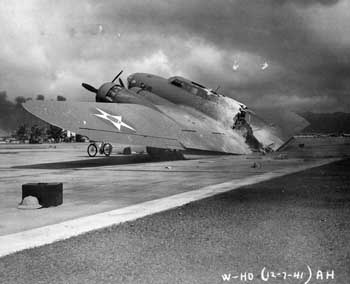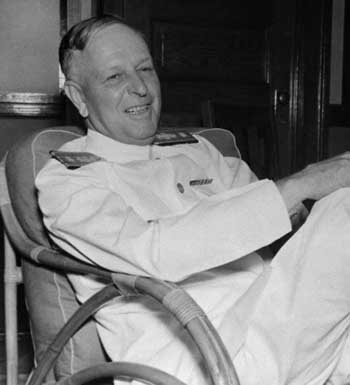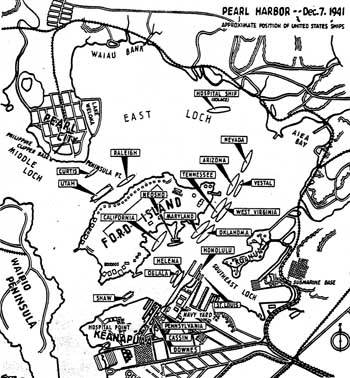Pearl Harbor: Case Closed?
Book Reviews
Day of Deceit: The Truth about FDR and Pearl Harbor by Robert B. Stinnett. New York: Simon and Schuster, Touchstone, 2000. Paperback. 399 pages. Index, illustrations, maps.
Pearl Harbor Betrayed: The True Story of a Man and a Nation under Attack by Michael Gannon. New York: Henry Holt, 2001. Hardcover. 340 pages. Index, illustrations, maps.
As the sixtieth anniversary of what President Franklin Roosevelt called “a date which will live in infamy” (and who would know that better than he?) passes, the controversy over Pearl Harbor is as lively as ever. In no other area of the history of the Second World War have revisionists had quite as much success in convincing a broad section of public that the official version has it wrong: that it is President Franklin Roosevelt, not local commanders General Walter Short and Admiral Husband Kimmel, who should bear the blame for the devastating Japanese attack.
Two recent books argue that Admiral Husband Kimmel, in particular, was gravely wronged by his superiors, not merely after December 7, 1941, but in the weeks and months before. One, Robert Stinnett’s Day of Deceit, is radically revisionist, claiming to abound in new evidence for a conspiracy involving the president, the war and navy departments, the army chief of staff, and the chief of naval operations, among many other participants. The other, Michael Gannon’s Pearl Harbor Betrayed, makes no explicit accusations of conspiracy, nor does it seriously fault America’s confrontational diplomacy vis-a-vis Japan in the years leading up to the attack. Odd as it might seem, this reviewer found the second the more satisfying book.
Stinnett has worked for many years on the question of whether American leaders, civilian and military, had foreknowledge of the Japanese attack on America’s army and navy bases on Oahu. His review of the diplomatic evidence merely confirms what Charles Beard, George Morgenstern, Harry Elmer Barnes, Charles Callan Tansill, Percy Greaves, James Martin, and other revisionists have firmly established: that Roosevelt, Secretary of State Cordell Hull, and Secretary of War Henry Stimson desired, and provoked, war with Japan, and that they certainly knew that Japan was going to war a day or more before the December 7 attacks (which hit U.S. bases in the Philippines as well).
Stinnett’s attempts to establish that America’s civilian and military leadership was, or should have been, privy to the Japanese plans for Pearl Harbor through the interception and reading of certain of Japan’s naval codes is harder to credit. A fair amount of his case rests on a sizable number of messages from ships and units of the Japanese navy that Stinnett was able to make public for the first time, not without diligent effort, under provisions of the Freedom of Information Act. It is difficult for a layman to interpret the significance of these documents, however, for Stinnett often fails to provide such key details as how they were routed and when they were read. Many of Japan’s pre-Pearl Harbor messages were decoded only after the war.
A central contention of Day of Deceit is that American cryptanalysts solved the main operational code of the Japanese navy (designated as the “5-Num code,” for its five number groups, by the code breakers) well in advance of the post-Pearl Harbor solution date accepted by most historians. On page 71 Stinnett writes that not only the Americans, but also the British, the Dutch, and the Chiang Kai-shek’s Nationalist Chinese had solved the 5-Num code by fall of 1941. Here, however, he is writing of three other codes as well, so the reader must leaf back to page 23 to discover that “Recovery [of the 5-Num code] was effected [by the U.S.] before April [1941].”

The wreck of an American B-17 bomber at Hickam air field, Hawaii, December 7, 1941. After being attacked while in the air by Japanese fighter planes, it came down in flames and broke in half upon hitting the ground.
But what does Stinnett mean by “recovery”? In numerous passages he implies that the code was fully cracked and readable by the date he has given, and an uncareful reader of his pages 73-81, the section of Day of Deceit that deals most thoroughly with the decoding of the 5-Num code, will likely take it that this was the case. Yet Stinnett supplies little documentation about just how much of this key Japanese naval code – the U.S. Navy’s ability to read it was the key to the stunning American victory at Midway in June 1942 – could be understood before Pearl Harbor; none of his sources demonstrates that more than a small fraction of the chief operational code of the Japanese fleet could be read until later. His habit of grouping facts under a blanket statement that doesn’t cover all of them can’t disguise that what he calls on page 73 “an example of Num-5 and SM [ship movement code] decryption” turns out to have been merely an example of SM code decryption. Stinnett could have spared his readers a good deal of confusion and frustration by featuring more prominently a statement, buried at the bottom of a long footnote, that seems to be his clearest and most unambiguous statement on the matter: “There is no reliable evidence, found by the author, that establishes how much of the 5-Num text could be deciphered, translated, and read by naval cryptographers in 1941.” (p. 334, n. 18)
Stinnett hasn’t made things any easier for his readers by his often disconcerting manner of exposition. Although a retired journalist, Stinnett tends to overcomplicate his story. His exposition, particularly in the first several chapters, is complicated, and sometimes nightmarish, for he makes repeated, arbitrary cuts back and forth, both in theme and chronology. Whether these jarring shifts are due to authorial wool-gathering and editorial negligence, or whether they are part of some deliberate purpose, they make concentrating on the facts a constant chore. In turn, the frequent jumps force endless repetition, which does little to smooth the muddy flow. Just as bad, he can be a master at deflating his own suspense: Day of Deceit begins with breathless account of Edward R. Murrow’s claim that he had gotten the biggest story of his life at a meeting with FDR on the evening of December 7 (“The Biggest Story of My Life”), but the biggest story turns out to be … nothing. “In the end, Murrow’s story remained unwritten and unbroadcast.”
Stinnett makes much of a memorandum that he discovered in the National Archives and which he believes explains U.S. policy toward Japan from October 1940 on. Written by the chief of the Office of Naval Intelligence’s Far East desk, Lieutenant Commander Arthur McCollum, the eight-part memorandum calls for U.S. diplomatic and military measures, in conjunction with British and Dutch forces in the South Pacific, aimed at driving the Japanese to the wall. These measures included imposing a total embargo on Japan, aiding Chiang Kai-shek, and moving U.S. forces westward, to include bases in Singapore and the Dutch East Indies, and the basing of the “main strength” of the U.S. fleet in the vicinity of the Hawaiian islands. Confrontational though these proposals were, Stinnett is not able to show that Roosevelt or any other high official ever saw them. Several were not adopted, including the proposed colonial bases; one or two were in force before the memorandum; in one case the author has equated a handful of U.S. cruiser sorties in and around Japanese waters (most of them near Japanese mandates in the Pacific) with the stationing of a division of heavy cruisers in the Far East. In any case, the McCollum memorandum would seem to be incidental to Roosevelt’s and the well-known Japanophobe Stimson’s growing need for a “back door to war.”
Many of Stinnett’s allegations are highly technical and demand fairly expert treatment, but nearly any reader will be given pause by the vast conspiracy to deny General Short and Admiral Kimmel knowledge of the attack that Stinnett posits in this book. Starting with Roosevelt, Stimson, Hull, Secretary of the Navy Frank Knox, Chief of Naval Operations Harold Stark, and Chief of Staff George C. Marshall, it runs down a long roster of top officers, including General Douglas MacArthur. Especially prominent among Stinnett’s culprits are officers from naval intelligence and signals intelligence, including Commander Joseph Rochefort, the chief naval cryptographer in Hawaii; Lieutenant Commander Edward Layton, Admiral Kimmel’s fleet intelligence officer and his ardent defender in later years; and Commander Laurance Safford, the U.S. Navy’s chief code breaker and a man who, if Stinnett is to believed, must have fooled plenty of the revisionist historians with whom he worked closely on the Pearl Harbor question over the decades. Various of Stinnett’s allegations leave an unsavory taste, such as his repeated implication that Admiral Walter Anderson, former chief of naval intelligence, commander of battleships at Pearl Harbor on December 7, resided away from the naval base due to foreknowledge of the attack.
While some, or even much, of the material that Stinnett has been able to have declassified and released may be of use to revisionists, to this reviewer Day of Deceit raised many more questions than it satisfactorily answered. Until these are answered, Stinnett’s book is potentially a dangerous one, far more so to revisionists than to partisans of the official version on Pearl Harbor.
Michael Gannon’s Pearl Harbor Betrayed, on the other hand, is an outstanding example of historiographical writing: it is well-organized, well-documented, and in its depiction of the well-worn story of the Japanese attack, fresh, informed, and dramatic.
Like Stinnett, Gannon defends Admiral Kimmel’s response to the attack, and far more actively.
Sometimes, in reflecting the deep loyalties of Kimmel’s family and his fellow officers, he sounds a bit like a cheerleader. This is quite pardonable, however, in view of the grievous and unjust harm done Kimmel’s reputation (he was relieved of command and labeled derelict of duty) in order to clear Roosevelt, Stimson, Marshall, Stark, and their henchmen for, at the very least, failing to provide the commander of the Pacific Fleet and the commander of the Hawaii Department, General Short, with the men, materiel, and information necessary to defend their commands.
Gannon is particularly strong on Washington’s failure to provide Kimmel (and Short) with the ships, planes, and guns needed to defend Pearl Harbor and the other bases on Oahu, where the fleet’s headquarters had been transferred only over the strong objections of Kimmel’s predecessor, Admiral Richardson. He stresses that, as the Roosevelt administration was gearing up to involve America in a war against Germany, it was not merely failing to provide Pearl Harbor with the means to defend itself, it was systematically stripping Hawaii of its defenses, diverting ships from the Pacific Fleet to anti-German purposes in the Atlantic, and sending patrol planes and advanced fighter planes desperately needed in Hawaii to Great Britain and the Soviet Union. Gannon provides a thorough, even vivid account of Kimmel’s efforts to get his fleet battle ready. As he notes, the fleet’s anti-aircraft guns were manned and firing within four minutes of the opening of the attack, but their guns were out of date and nearly useless against fast, low-flying planes.

Admiral H.E. Kimmel during a relaxed moment, prior to his appointment as commander of the U.S. Pacific fleet.
Gannon pretty much toes the line regarding a unilaterally aggressive Japan; on the other hand, he is quite acute in noting the progressive violations of neutrality by FDR in his undeclared naval war in the Atlantic in alliance with England. Here the research he has done in conjunction with Operation Drumbeat, his much hailed account of the initial German submarine campaign against American shipping, and other works continues to prove its worth. He has even discovered orders from Admiral King, commander of Atlantic fleet, to the captains of his escort ships authorizing them to shoot on sight in July 1941, well before FDR’s issuance of that order following the Greer incident in September. Gannon makes clear that he is at least mildly contemptuous of such Roosevelt stratagems as decreeing that the Western Hemisphere extended to the east of Azores, or occupying Iceland (to which he compares the Japanese occupation of Indochina).
Pearl Harbor Betrayed offers a detailed and careful account of all the major issues in the Kimmel case. In nearly every instance the author comes down on the admiral’s side, and against his political and naval superiors in Washington. Gannon methodically demonstrates that Kimmel could not have done a better job of air reconnaissance with the planes available to him, and that he was denied key intelligence, including access to Japan’s top-secret diplomatic code (called “Purple”) and to reports from a Japanese naval spy in Honolulu that clearly indicated an attack on Pearl Harbor (all of this intelligence was made available to U.S. commanders in … the Philippines!). Gannon is at his best in parsing the key orders Kimmel received from Admiral Richmond Kelly Turner, Chief of Naval Operations Harold Stark, and Secretary of War Henry Stimson in the final weeks and days before the attack: steeped in naval procedure, he shows that Kimmel, after being left blind by his superiors, was given imprecise, misleading, and wrongheaded directives that all but left him and his fleet sitting ducks. His defense of Admiral Kimmel makes the 1995 finding by Undersecretary of Defense Edwin Dorn that Kimmel and Short were not solely responsible for the fiasco, and the recent recommendation of Congress that the admiral be restored to his highest wartime rank, all the more satisfying.
Little of this, except for Gannon’s grasp of detail and bloodhound’s instinct for sources, is new to knowledgeable revisionists. And revisionists will rightly cavil at Gannon’s reluctance to lay more than a kind of procedural blame on Stark, Turner, et al., let alone Franklin Roosevelt, whom he seems to acquit in a footnote aimed at Gore Vidal’s unblushingly conspiratorial novel Golden Age (leitmotiv: FDR? Did he ever know!):
One need not hold FDR to blame for what happened at Pearl Harbor if one’s wish is to exonerate Kimmel and Short. One need only cite the faithlessness and ineptitude of the war and Navy Departments, about which much has been written in these pages. (p. 363, n. 62)
Bad as that sounds, Stinnett’s fulsome tributes to Roosevelt are worse, for he tells us that none of the numerous treacheries he attributes to Roosevelt throughout Day of Deceit “diminish Franklin Delano Roosevelt’s magnificent contributions to the American people.” What both authors really mean to say, of course, is that Holocaustomania is alive and well, and that any questioning of America’s entry in the great anti-fascist crusade is liable to render one an accomplice to the most recently discovered Holocaust crime.
The more important of these two books, Day of Deceit (if only for its ambition), may provide some new evidence for a conspiracy including FDR as well as his underlings, but seems untrustworthy. Pearl Harbor Betrayed is well worth reading, for its up-to-date consideration of the key questions as well as for the reasons stated above, but shies away from uncovering a conspiracy. The book that solves the Pearl Harbor mystery, however, remains unwritten.
Bibliographic information about this document: The Journal of Historical Review, vol. 20, no. 5+6 (September/December 2001), pp. 70-74
Other contributors to this document: n/a
Editor’s comments: n/a


